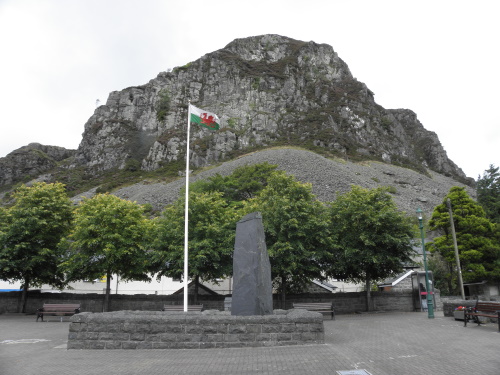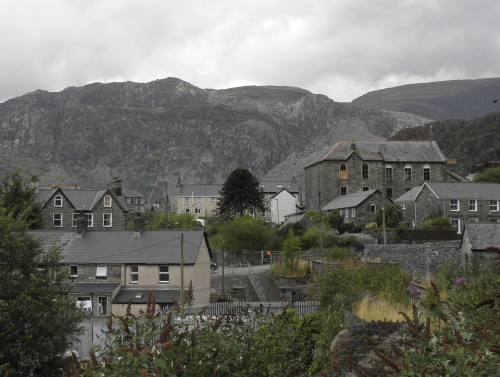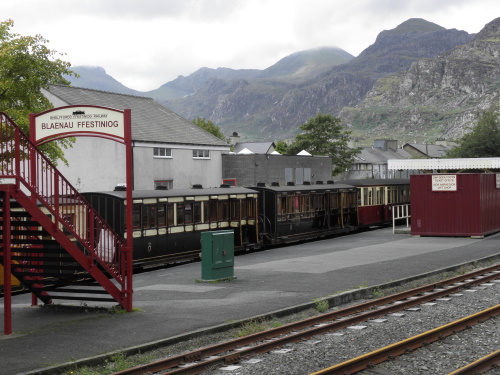Blog TWHS Visits
WHC 2021: The Slate Landscape
The Slate Landscape of Northwest Wales is the UK’s nomination for 2021. It will be a serial site with 7 components. Each of the components consists of a number of ‘elements’ – the most noteworthy “physical features which embody the attributes of Outstanding Universal value”. That value is to be found in (ii) the technology transfer to continental Europe and the USA, (iv) the dramatic impact of large-scale exploitation of natural resources and (v) the legacy of the industrial workers and their settlements. Its official name has been changed from “Slate Industry ..” to “Slate Landscape”, obviously emphasizing the cultural landscape approach.


I visited one of the components, the town of Blaenau Ffestiniog, on my way to the Gwynedd Castles in 2011. I’ve got a couple of photos left, but I must admit that I did not write up anything about the side trip and I can remember almost zero. What I see when I look at those photos again is a town that could only be in the UK: straight rows of similar stone houses (cheap housing for the quarrymen), a fish and chip shop, an Anglican church (they call it “Church of Wales” over here), a WWI memorial. It is surrounded by steep natural hills and man-made waste dumps. All photos appear to be taken in black-and-white as grey is the prominent colour of it all (including of course the slate roofs).

At the center of the town lies a railway station, which is the terminus of a narrow-gauge heritage railway. It was originally built to connect the quarries with the sea. The railway tracks and the “sense of arrival” (when doing so by train) are prominent features in the WH nomination. Most of the photos that I still have are railway related, so it must have been the town’s most impressive sight. In hindsight, St. David’s Church (now advertising bilingual services but in the past all churches preached in Welsh) and the market hall with interesting architecture might have warranted a closer look.

Desk research in 2020 reveals that there is a (slightly outdated?) nomination website available in Welsh and English, and the Management Plan can be found online as well. It is all well-presented and I don’t think there will be many objections getting it inscribed. But just as with my short visit, the presentation does leave an aftertaste of “Is this special enough?”. There was no element mentioned where I’d would be really interested enough to go back for a ‘proper’ visit. There’s the social history of course and the exploited landscape - this recent work might be an interesting read to get a better feel for the Welsh Slate history. Excerpts are readable for free online.
In ICOMOS’s Filling the Gaps document of 2005, that had the goal of identifying under-represented categories, post-Industrial Revolution technological properties located in Europe and North America were considered “overwhelmingly” present already. However, in the years since several more have been added to the List. Among those is for example the Cornwall and West Devon Mining Landscape which is geographically and thematically close to the Welsh Slate Industry Landscape. One of its arguments in the comparative analysis was that tin mining was not represented yet, and – indeed - slate mining also isn’t. But do we really need all imagineable resources represented?
Els - 15 March 2020
Comments
Els Slots 16 March 2020
Re: "(“WHC 2021: The Slate Landscape”) implies that it is the first of a series of “retrospectives” on upcoming nominations" -> no it isn't, I have used it before as a label to identify a TWHS review that is close to inscription. Do not plan more. I have 1 unreviewed TWHS in the pipeline and for the remaining weeks I indeed plan to fall back on thematic posts (meta blog posts as Nan calls them).
Nan 15 March 2020
I skipped past it when I tackled Wales, but Snowdonia and Anglesay seem like nice places, that I might squeeze a visit in if inscribed.
Re Cornwall: For me, this belongs on the list and it should have been submitted earlier. My only critique: The inscribed site is just too broad and should have been more focused.
Re future blogs during travel ban: Personally, I like the discussion and meta blog posts best. Those also seem to be the ones that gather the most discussion/community feedback. On the other hand, I did not expect this post to gather this level of feedback.
Re future nominations: I agree that the overall pipeline is less than stunning. So much so, that I am wondering if I shouldn't travel with the List 2020 as fixed goal.
The problem, though, is not that there aren't any worthwhile tentative sites out there. It's more that it's always the same countries submitting, most of them having exhausted their list or being too single minded.
For Germany, I really don't see any reason to keep submitting that many sites. I think it would be good to simply stop. Maybe Spas und Neuschwanenstein and stop.
For the UK, do you really need more mines and industrialization sites?! Scotland, meanwhile, would offer way better opportunities.
On the opposite, is Ireland who have great sites but seem not at all interested in submitting them. And other (more often than not poorer) countries don't make any efforts.
Solivagant 15 March 2020
Hi Els
I don’t know if your title for this Blog (“WHC 2021: The Slate Landscape”) implies that it is the first of a series of “retrospectives” on upcoming nominations. With new travel likely to be very restricted for some months to come, that may indeed be the only way of finding “new” blog subjects!!
I don’t normally leap to the “protection” of negatively reviewed sites (especially not those from UK which might smack of “special pleading”!) but do fear that a review of a visit which only “saw” a railway station (apparently with no trains!), some “cheap housing”, “waste dumps”, a fish and chip shop and a landscape dismissed as “grey”, might not give a fair impression of the site and might lead some visitors to miss/not seek out what it does offer! (Naturally) I would suggest looking at my own review which encompasses rather more of the site! That said, the site certainly isn’t a “great” one or worthy of our “Top 50 missing” - I will probably give it 2.5 stars if it is inscribed – my “WHS average” but ahead of many other mining sites.
Perhaps more interesting is your comment that it lacks originality or novelty since, even if slate mining isn’t currently represented, then many sites covering the sourcing of other resources are (“…but do we really need all imaginable resources represented”?). This led me to look at other upcoming nominations for 2021 (no doubt the same could be done for 2019 and 2020 with similar conclusions).
There are 38 (including 1 other mine at Roșia Montană) - but how many would pass a strict “originality” test? In fact nearly all of them are “repeats” - mosques, missions, mediaeval town centres, mountains etc. A few hit the button of also being reasonably “iconic” in World terms – if not at the highest level (Sarnath). Some are incredibly convoluted in their attempt to identify a new “slant” on an old theme (Ljubliana, Nice, the SHUM cities.). All that can be said is that there isn’t a vineyard CL this year!! Among them I wouldn’t pick out the Slate industry nomination as being the most egregious example of “me too-ism”!!! Indeed the ONLY really novel nomination is the one which causes the most controversy and is most likely to be rejected – the WWI Funeral Sites.
The reality is that the entire WHS nomination system now is sclerotic with most nominations being variations on a number of standard themes, each trying to identify a USP to differentiate it from its near “relatives".
Returning to the Slate Nomination and “greyness”. Anyone with access to BBC might be interested in seeing the murder/detective drama “Criath” in Welsh (sub-titled “Hidden”). This makes Nordic Noir look like a comedy show and series 2 centres on Blaenau Ffestiniog! I quote from a couple of reviews “A Nightmare for the Welsh Tourist Board…… So this is Wales? It never gets fully light in the day. It's always raining. Everybody is depressed. Everybody is on drugs. Everybody has a dark past. Horrible feral kids murder people & stab each other. Feral dogs bark all the time.
Nobody smiles.” And “...this is downright depressing. A whydunit rather than a whodunit we are besieged with bleak shots of bleak lives in bleak Welsh villages. Even the beautiful countryside is shot to highlight its bleak and barren features.” Sounds like it had that impression on you too Els!!!
Ilya Burlak 15 March 2020
Thanks to your post, Els, I also realized that I may "have been" to another TWHS. Back in 2008, while living in London, we took a week-long trip around Wales, and specifically stopped for a tour of Llechwedd Caverns in Blaenau Ffestiniog. My notes suggest that the tour was fairly disappointing - although the kids, as I recall, enjoyed it well enough - and we did not actually stop in or saw much of the town. A borderline visit by any definition, although I suspect that if it ever makes it to the list, the actual mine has got to be part of it.
Tsunami 15 March 2020
I realize I have been to the train station of Blaenau Ffestiniog. After visiting the Conwy Castle and staying over at Betws-y-Coed in 2009 I took a train (or a bus) to Blaenau Ffestiniog in order to take a bus to another train station on the coastal railway (I also saw the Harlech Castle from the train.) that connects to Shrewsbury. The reason I suddenly remembered this is because of the stone monument in the Els' first photo here. I was just able to dig up my photo of the monument (with a plate) from a different angle. I did not even know what it was for at that time (The nomination was announced in 2012). But the plate in my photo seems to say "This Slate Fountain was donated to the town by the Ffestiniog Chamber of Trade." So was it a fountain? All I remember is that it reminded me of the monolith in Kubrick's 2001, especially because of the angle I took my photo.